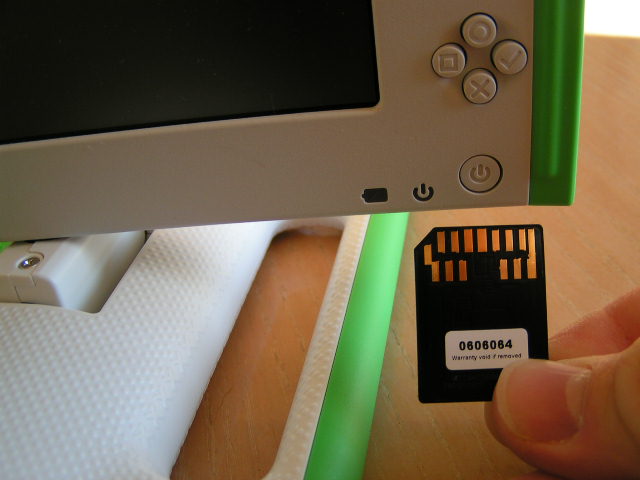Secure Digital card
The XO laptop has 1 MMC/SD/SDHC slot. SD cards and USB flash drives are automatically mounted in the Journal activity. The Journal entry shows you how to access the add-on memory devices. This is intermitant in the first release You can move files to and from the storage media. by commandline and... See discussion Talk:Secure_Digital_card to talk about your situation.
Contents
Use
- insert card (noted below)
- device will show up in journal if correctly mounted. an error message may briefly flash when booting if it didn't work, but other than that you can do a "df" or "cat /etc/mtab" or "cat /etc/fstab" to see what's up
- to safely remove the device, click on it in the journal (lower left side most likley), and choose unmount.
- if it's currently in use, this will happen :???
Supported cards
- FAT16, FAT32 formatted
- 8-gigabyte SD memory cards work. As larger cards are created, they will also be tested. 16GB cards have been reported to work.
- No word on straight old MMC cards—even though they should work, some other hardware doesn't let it work.
Implementation
XO uses a custom microchip for SD card access, Camera and Flash Enabler, or CaFE. CaFE includes SDHC support. SDHC is compatible at a hardware level with SD. (it can't be, HC has got extra pins!!! AaronPeterson 02:39, 3 January 2008 (EST)) Pierre Ossman wrote the Linux driver support for SDHC. SD cards up to something like 256 GB should be supported. cafe is driven by the sdhci driver. cafe follows the standard host controller interface for SD controllers.
SD standard
Here is how SD block addressing works: The address is 32 bits. In the CaFe chip, which is compatible with the standard "SDHCI" spec, the address goes in the 32-bit chip register at offset 8. For old SD cards (not the new SDHC - High Capacity cards), the address is a byte address, so the maximum size is 4 Gbytes. For the newer SDHC cards, the address is a block number, assuming 512 byte blocks, so the maximum size is 2 TBytes. None of this is CaFe-specific, BTW. It is standard SD. In other words, SDHC just shifts the addresses by nine bits, allowing an effective 40 bit address. The other limit that's often written about, 32GB, is an artificial limit in Window's FAT formatter; Windows will use the generally incompatible NTFS instead. Linux can format FAT up to the ~300GB real limit just fine, after that we'll need to use a linux specific fs.
Exceptions
When they don't mount
I Installed (2) different USB sticks on my new XO and also a miniSD(with SD adapter) and none of these (3) items are showing up in the Journal. I'm unable to access any of these and don't understand what I'm doing wrong. The USBs are both U3 Launchpad enable (only one is password protected). How can I make these Items work?
A: Make sure both cards have different Volume labels, as that's how they're assigned a mount point. See [1]
- There's a hidden folder the OLPC puts onto all mounted media, ".olpc.store/". Try removing that, a broken database there may keep the journal from working properly. You should always be able to see the device mounted using "df" in Terminal.
- Also, make sure they are FAT-formatted (most new USB sticks come FAT-formatted)—I think both FAT16 and FAT32 work. Also, I think the sticks/cards need to be writable for Sugar to index them correctly, so if your stick or card comes with a read-only switch, make sure it is in the read/write position and not the read-only position. I don't know much about the U3 system, but you might want to try non-U3, non-password-protected sticks to eliminate the possibility that your hardware is defective. If regular, brand-new sticks are not working, it is possible there is something wrong with the hardware of your machine, in which case you may want to contact the support line to see if it needs to be replaced (within the 30 day warranty period, if possible). —Joe 02:29, 29 December 2007 (EST)
Insertion
Note: The SD/MMC/SDHC memory card will only mount when inserted properly into the XO laptop. The slot will allow you to insert the card in either direction however. (It did not let me do that AaronPeterson 02:39, 3 January 2008 (EST))
To properly insert the SD/MMC/SDHC card the brass fingers on the card should be facing up and towards the front of the LCD screen. Insert the card until it is flush with the bottom of the screen, you will hear a click when the card is fully seated. [I had a hard time getting the card come out again. Using small tweezers I finally succeeded. Next time I attach a little piece of scotch tape to the SD card; this will give me an easy handle to pull the card out when it gets stuck. Geert December 28, 2007]
The picture below shows the proper way to insert the SD/MMC/SDHC card:
--KenXo 11:28, 24 December 2007 (EST)
Error Messages
I get an error about not being able to read block 0 of mmc1 when I turn on my XO. I've tried two cards, and those worked on another person's XO. I can't do anything to mount them AaronPeterson 02:39, 3 January 2008 (EST)
